Towards the end of Masechet Ketubot (pages 103-104) we have the long and magnificent deathbed story of Rebbe, Rabbi Judah the Prince. The Gemara brings many death (and post-death) stories, where the rabbis tell us their last thoughts, life advice and regrets. For example, Rabbi Elazar ben Hyrcanos on his deathbed bemoans that he has taught so little of the vast Torah that he knows:
“Rabbi Eliezer raised his two arms and placed them on his heart, and he said: Woe to you, my two arms, as they are like two Torah scrolls that are now being rolled up , . . I have taught much Torah, and my students have taken away from me, only like the tiny amount that a paintbrush removes from a tube of paint.. “(Sanhedrin 68a)
Within this deathbed tradition, Rebbe’s story stands out as long, detailed and physically anchored to a place that is well-known today, the necropolis of Bet Shearim. Let us begin there.
Bet Shearim is a site located in the lower Galilee, near the entrance to the Jezreel Valley. While there had been some preliminary surveys done there in the late 19th and early 20th centuries, nothing of great importance was discovered. In 1926 Alexander Zeid, one of the founding members of the Shomer organization, came and settled in what was then called Sheikh Abrek to protect Jewish-owned land there. In the course of his patrolling and farming, he uncovered an ancient cave with Hebrew and Greek inscriptions and a menorah. He excitedly wrote to his colleagues, Yitzchak Ben Zvi and Benjamin Mazar, that they must come and excavate.
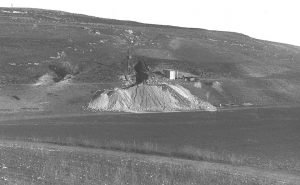
Bet Shearim at the beginning of excavations
Government Press Office (Israel), CC BY-SA 3.0 <https://creativecommons.org/licenses/by-sa/3.0>, via Wikimedia Commons
His excitement was contagious and excavations began in 1936 and continued until 1940 (tragically, Zeid was murdered by an Arab attacker in 1938). The site was excavated again in the 1950s, the archaeologists were Benjamin Mazar and Nahman Avigad. They uncovered a series of burial caves with elaborately carved doors and sarcophagi. In the 2000s excavations were done on the nearby town and so far we have uncovered the town gate, a synagogue, a large building that may be a study hall/bet midrash, and olive presses.
While it is exciting to uncover the town, the necropolis is the more unusual and exciting find. In over twenty burial caves, one with more than one hundred and thirty sarcophagi, are inscriptions in Hebrew, Greek and Aramaic, attesting to people brought for burial from places as far ranging as Alexandria, Antioch, Palmyra and Yemen. The professions listed in the inscriptions range from leaders of towns to money changers, doctors, merchants and sailors. The sarcophagi display everything from the simplest lettering and geometrical decorations to mythological figures like Leda and the swan, showing that not all the Jews buried here held the same views about imagery and pagan figures.
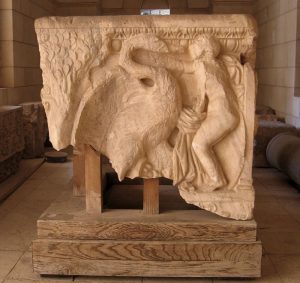
Talmoryair, CC BY 3.0 <https://creativecommons.org/licenses/by/3.0>, via Wikimedia Commons
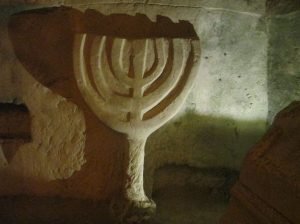
user:Avi1111, CC BY 4.0 <https://creativecommons.org/licenses/by/4.0>, via Wikimedia Commons
Why did such a broad range of Jews arrange for their last remains to be brought here to this small Galilean town? They may not all have been learned, or even particularly careful about tradition and Jewish law, but they wanted to be buried next to one of the greatest figures of the age: Rabbi Judah the Prince:
“It is taught in a baraita: Rabbi Yehuda HaNasi was lying ill in Tzippori and a burial site was ready for him in Beit She’arim.” (Ketubot 103b)
The phenomenon of a famous grave attracting others to be buried nearby is well known in Judaism as well as in other religions. The most famous example in Israel is the desire “to be buried with the sleepers of Hebron,” להיקבר עם ישיני חברון, i.e., the Patriarchs and Matriarchs. In Bet Shearim the real estate of the afterlife became very valuable once Rebbe chose it in life and in death. Today the necropolis is a national park and you can visit many of the caves and see the fabulous sarcophagi.
But what about the actual grave of Rebbe, can we identify where it is? We have a few clues about how it should look, both from our story here as well as from other sources. Here in Ketubot we find that Rebbe told the Sages about the three people who would carry on his legacy:
“I need the Sages of Israel. The Sages of Israel entered his room. He said to them: Do not eulogize me in the small towns and reconvene the study sessions at the yeshiva after thirty days of mourning. My son Shimon is a Sage. My son Gamliel should be the Nasi. Ḥanina bar Ḥama will sit at the head of the yeshiva.” (Ketubot 103a-b)
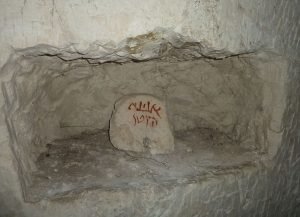
Reconstructed inscription of Anina HaKatan
Deror_avi, CC BY-SA 3.0 <https://creativecommons.org/licenses/by-sa/3.0>, via Wikimedia Commons
The names of these three: Gamliel Shimon and Anina (=Hanina) were found on the walls of cave #14, a cave with a fabulous entrance but a very unassuming interior.
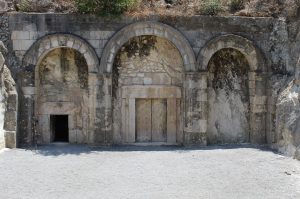
The exterior of cave #14
Hebrew Wikipedia, CC BY-SA 3.0 <http://creativecommons.org/licenses/by-sa/3.0/>, via Wikimedia Commons
Deep in the recesses of this cave are two rectangles dug into the ground – simple graves without fancy sarcophagi. This fits with the version of the story in the Yerushalmi:
“Do not give me too many shrouds and let my coffin be dug into the earth” (Yerushalmi Kilaiim 9:3)
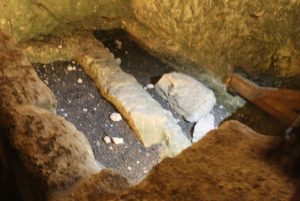
Hanay, CC BY-SA 4.0 <https://creativecommons.org/licenses/by-sa/4.0>, via Wikimedia Commons
Perhaps most intriguing, above cave #14 are benches cut into the stone. They provide space for a good number of people to sit. Could this be what Rebbe meant when he asked to convene the assembly after thirty days (Ketubot 103)? Rashi on Yevamot 122a cites a tradition of the Geonim that on the anniversary of a great man’s death, scholars come and study in a place above his grave.
The great irony of Rebbe’s grave is that despite it being one of the most authentic of ancient graves, it is not visited by a steady stream of the people who like to pray at graves. Is this because it is in a national park and it costs money to come here? Or because it has been taken over by the “Zionist establishment?” I do not know, but learning a mishnah in the “yeshiva” above Rebbe’s grave is a powerful and awe-inspiring experience for anyone who is committed to Torah knowledge.
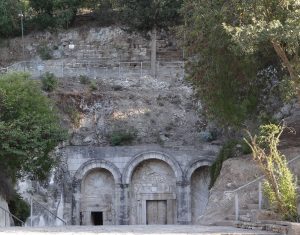
Benches above cave #14
Hanay, CC BY-SA 4.0 <https://creativecommons.org/licenses/by-sa/4.0>, via Wikimedia Commons










